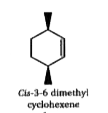The stable form of trans-1, 4 dimethylcyclohexane is represented as:




The correct Answer is:C
To determine the stable form of trans-1,4-dimethylcyclohexane, we will follow these steps:
Step 1: Understand the Structure
Trans-1,4-dimethylcyclohexane has two methyl groups (−CH₃) attached to the cyclohexane ring at the 1 and 4 positions. The "trans" configuration indicates that the two methyl groups are on opposite sides of the ring.
Step 2: Draw the Cyclohexane Ring
Draw a cyclohexane ring. Label the carbon atoms from 1 to 6.
C1C6C2∣∣C5C3 C4
Step 3: Place the Methyl Groups
Since we are dealing with trans-1,4-dimethylcyclohexane, we will place one methyl group at carbon 1 and the other at carbon 4.
Step 4: Determine Axial and Equatorial Positions
In a cyclohexane chair conformation, each carbon has one axial and one equatorial position. The axial position is perpendicular to the plane of the ring, while the equatorial position is roughly parallel to the plane.
Step 5: Identify the Most Stable Configuration
To achieve the most stable configuration, bulky groups (like methyl groups) should be placed in the equatorial position to minimize steric hindrance.
1. Configuration 1:
- Methyl at C1 (equatorial) and methyl at C4 (equatorial) - Most stable
2. Configuration 2:
- Methyl at C1 (axial) and methyl at C4 (equatorial) - Less stable due to steric hindrance.
3. Configuration 3:
- Methyl at C1 (equatorial) and methyl at C4 (axial) - Less stable due to steric hindrance.
4. Configuration 4:
- Methyl at C1 (axial) and methyl at C4 (axial) - Least stable due to maximum steric hindrance.
Step 6: Conclusion
The most stable form of trans-1,4-dimethylcyclohexane is when both methyl groups are in the equatorial position. Therefore, the correct representation of the stable form is the one where both methyl groups are equatorial.
Final Answer
The stable form of trans-1,4-dimethylcyclohexane is represented as the configuration where both methyl groups are in equatorial positions.
---
Trans-1,4-dimethylcyclohexane has two methyl groups (−CH₃) attached to the cyclohexane ring at the 1 and 4 positions. The "trans" configuration indicates that the two methyl groups are on opposite sides of the ring.
Draw a cyclohexane ring. Label the carbon atoms from 1 to 6.
Since we are dealing with trans-1,4-dimethylcyclohexane, we will place one methyl group at carbon 1 and the other at carbon 4.
In a cyclohexane chair conformation, each carbon has one axial and one equatorial position. The axial position is perpendicular to the plane of the ring, while the equatorial position is roughly parallel to the plane.
To achieve the most stable configuration, bulky groups (like methyl groups) should be placed in the equatorial position to minimize steric hindrance.
- Methyl at C1 (equatorial) and methyl at C4 (equatorial) - Most stable
2. Configuration 2:
- Methyl at C1 (axial) and methyl at C4 (equatorial) - Less stable due to steric hindrance.
3. Configuration 3:
- Methyl at C1 (equatorial) and methyl at C4 (axial) - Less stable due to steric hindrance.
4. Configuration 4:
- Methyl at C1 (axial) and methyl at C4 (axial) - Least stable due to maximum steric hindrance.
The most stable form of trans-1,4-dimethylcyclohexane is when both methyl groups are in the equatorial position. Therefore, the correct representation of the stable form is the one where both methyl groups are equatorial.
The stable form of trans-1,4-dimethylcyclohexane is represented as the configuration where both methyl groups are in equatorial positions.
Similar Questions
Knowledge Check
Which of the following will give a mixture of cis and trans-1,4-dimethyl cyclohexane, when undergo catalytic hydrogenation ?
A B
B C
C DBoth (a) and (b)
DBoth (a) and (b)
The most stable form of cis cyclohexane -1,3-diol is represented as :1
View SolutionWhich would be the most stable conformation of trans-1-ethyl-3-methylcyclohexane ?
View SolutionThe least stable form of hydrogen is
View SolutionDraw the most stable conformation of (a) 1,2-dimethylcyclohexane, (b) cyclohexane-1,3-diol
View SolutionWhich is more stable, cis - or trans-1,2-dimethyl cyclobutane and whyh?
View SolutionWrite down the bond line structure of the following:
Trans-1,2-dimethylcyclohexane
View SolutionWrite down the bond line structure of the following:
Trans-1,2-dimethylcyclohexane
View Solution
